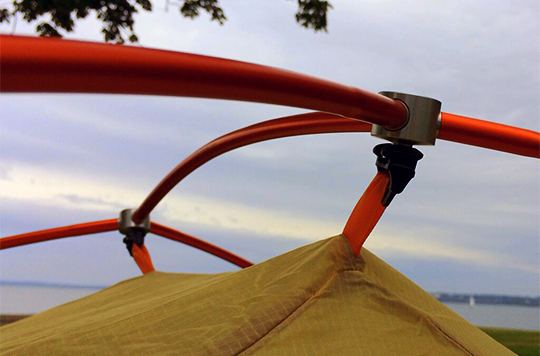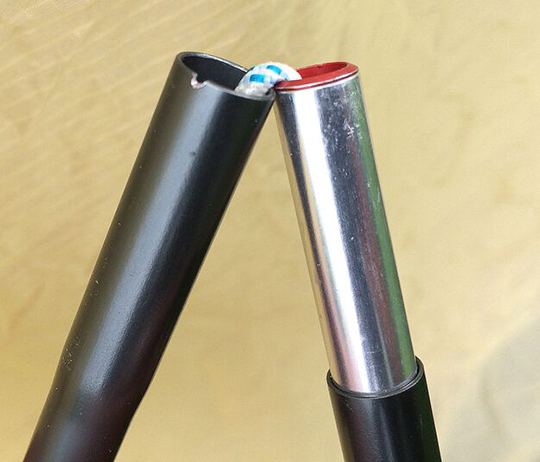[Photo] Kel Rossiter
MSRP: $699.95
After flying into Lower Ruth Gorge in early May–following a five-day wait while more than two feet of snow fell–I began to doubt my “dark horse decision” to bring along the Big Agnes Battle Mountain 2 tent. I’ve always had a soft spot for the dark horse, the little guy, and Big Agnes is certainly a David among a field of tenting Goliaths like Mountain Hardwear, MSR, and Sierra Designs. When we landed, I gazed across an endless sea of white and pondered the Ruth’s reputation as a wind tunnel, and wondered how well the relatively lightweight (6 pounds, 3 ounces) Battle Mountain 2 would fare.
The Battle Mountain 2 tent is Big Agnes’ newest entry into the field of four-season mountaineering tents, and while I credit them for not simply recreating the current tent “wheel,” I did come to have reservations after three months of testing. After using the tent in Alaska, the Pacific Northwest and the Tetons, it’s still not clear if its innovative design flourishes, like a hub and spoke main pole, constitute true advancements in technology, or are simply changes.
The three crux points before considering the other merits of a climbing tent typically boil down to price, weight and space. For comparison’s sake, let’s pit the Battle Mountain against an alpine tenting standard, the Mountain Hardwear Trango 2. The Battle Mountain lists for $699.95, a hundred dollars more than the Trango. The listed minimum weight for the Battle Mountain is 6 pounds, 3 ounces, versus 8 pounds, 15 ounces for the Trango. As for space, the Battle Mountain boasts 38 square feet of floor space, plus 10 square feet for its dual vestibules, and 42 inches of head height. The Trango 2 offers 40 square feet of floor space, 17 square feet for its dual vestibules, and 38 inches of head height. Crunch these numbers and it’s difficult to reach an objective conclusion: The Battle Mountain costs more, but weighs less, and offers more head space than the Trango. The competing Trango is a relative bargain for its price, offering nine more square feet of space than the Battle Mountain, but weighs a hefty 2 pounds, 12 ounces more.
Landing late in the day on Ruth Glacier, I was happy that I practiced setting up the tent while we waited for good flying weather. With its unusual hub and spoke main pole design, and a lack of color-coding on poles and attachment points, I found that tent assembly was not intuitive. The main ridgeline pole has hubs on its ends, with two poles splaying out from each hub, and you’ve got to run through it a few times before it becomes obvious how the ridgeline pole orients to the tent body. Compounding this problem is the use of “press-fit” connectors to attach the tent body to the hubs (the same connectors are also used on the vestibule poles). Several times, I put the hub and spoke together and attached the poles to the tent floor only to discover that the press-fit connectors faced skyward rather than tentward. Additionally, while the smaller DAC twist clips work well for attaching the tent body to the frame, the larger DAC clips designed for clipping at pole intersections aren’t large enough, making the clips difficult to attach and prone to slip off the poles. Lastly, after setting the tent up six times, I noticed a small chip at the end of one of the DAC NSL poles.

[Photo] Kel Rossiter
During all setup situations, these design quirks were mere annoyances, but more extreme situations could yield more extreme outcomes. Beyond setup, the design quirks of the Battle Mountain could make field repairs challenging. There’s the hub-and-spoke connections system, press-fit connectors, and molded plastic DAC joints on the vestibule poles. I concluded that this tent requires more MacGyvering than the simple three-inch pole sleeve that fixes standard Trango-type setups. Factoring in the Battle Mountain’s non-intuitive setup and its unfriendly field repair, it is safe to say that it would not be a good choice as a fleet tent for outdoor and guide programs.
First, it’s the weight. It’s hard to shave 2 pounds, 12 ounces off an alpine pack, so finding that savings simply by changing tents is a sweet dream, which I appreciated in the Tetons and North Cascades. That weight savings, however, comes at the expense of floor space, and the hub and spoke pole system packs bulkier than standard systems. Another plus is the tent’s ample mesh gear loft. My OCD mind rested easy knowing where I could find sunglasses, toothbrush and TP. And when morning came, the fly’s hunter-orange color made the inside of the tent glow, and made the tent easy to spot in low-visibility conditions. On the flip side, with all the mesh that embellishes the interior, it’s surprising how the Big Agnes’ designers skimped on the doors, which have only a half-screen. Summertime nights could get sticky in this “4-season” tent.

[Photo] Kel Rossiter
During our first night in Ruth Gorge, the wind howled and our snow walls served as a funnel to blow snow into the vestibule, creating a three-foot drift. This chaos was unapparent inside the tent. Despite its weight savings, the Battle Mountain is a solid tent, and with North Cascades climbing trips coming this summer, its sub-seven-pound pack weight is appealing. While I would not recommend this as a program tent, the Battle Mountain’s slimmed-down weight makes it an attractive option once you’ve figured out its setup quirks and design foibles. With the Battle Mountain, Big Agnes has hurled a stone at the tenting Goliaths and, while it may not be a decisive victory, the tent emerges from the fray as a contender.
Pros:
* Shaves more than two pounds off your pack weight, when compared to competing tents. This is a big plus–although the tent also offers less total square footage.
* Ample mesh pockets on the interior make for tidy tenting.
* Pleasant color warms up early morning starts.
Cons:
* Unconventional hub and spoke setup, combined with a lack of color-coding, makes tent setup non-intuitive and requires familiarity to be efficient.
* Specialized tent parts like the DAC joints and press-fit connectors can complicate field repair.
* Half-screens on the doors mean this four-season tent gets warm during summer.
* Larger DAC clips don’t easily and effectively engage both poles at pole intersections.
* $100 more than comparable tents on the market.
Kel Rossiter is the owner and lead guide for Adventure Spirit Rock+Ice+Alpine, and guides in the Northeast, Pacific Northwest, Alaska and beyond. He is a certified AMGA Alpine and Rock Guide and holds a doctoral degree in educational leadership from the University of Vermont.